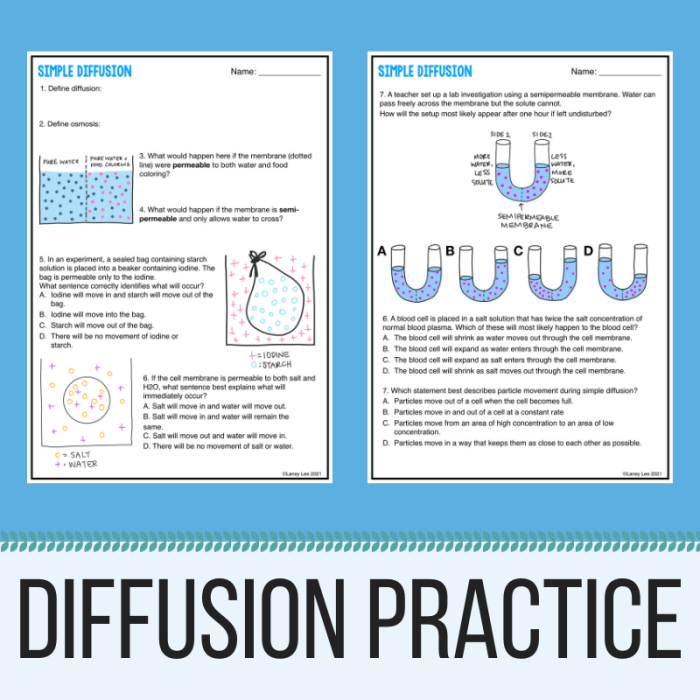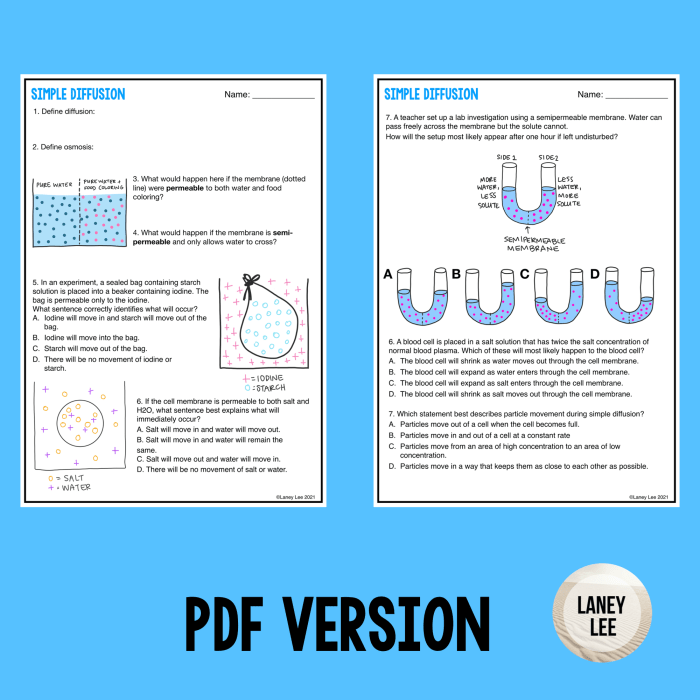Delving into the intricate world of cellular biology, we present the Osmosis and Diffusion Worksheet Answers PDF, an invaluable resource for students and educators seeking to unravel the mysteries of these fundamental processes. This comprehensive guide unveils the intricacies of osmosis and diffusion, equipping you with a profound understanding of their significance in everyday life and biological systems.
Prepare to embark on an enlightening journey as we explore the mechanisms, factors, and applications of osmosis and diffusion, empowering you with a solid foundation in these essential biological concepts.
Osmosis and Diffusion

Osmosis and diffusion are two fundamental processes that occur in living organisms. Osmosis is the movement of water across a semipermeable membrane from an area of high water concentration to an area of low water concentration. Diffusion is the movement of particles from an area of high concentration to an area of low concentration.
Osmosis, Osmosis and diffusion worksheet answers pdf
Osmosis is a passive process that does not require energy. The rate of osmosis is determined by the concentration gradient of water across the membrane. The greater the concentration gradient, the faster the rate of osmosis.Osmosis plays an important role in many biological processes, such as the absorption of water by plants and the excretion of waste products by animals.
Examples of Osmosis in Everyday Life
* The wilting of plants when they are not watered
- The absorption of water by a sponge
- The movement of water from a higher concentration to a lower concentration in a dialysis machine
Factors that Affect the Rate of Osmosis
* The concentration gradient of water across the membrane
- The temperature of the solution
- The surface area of the membrane
- The thickness of the membrane
Diffusion
Diffusion is a passive process that does not require energy. The rate of diffusion is determined by the concentration gradient of the particles across the membrane. The greater the concentration gradient, the faster the rate of diffusion.Diffusion plays an important role in many biological processes, such as the exchange of gases in the lungs and the absorption of nutrients in the small intestine.
Examples of Diffusion in Everyday Life
* The spreading of a perfume in a room
- The movement of oxygen from the lungs to the blood
- The absorption of nutrients from the small intestine into the bloodstream
Factors that Affect the Rate of Diffusion
* The concentration gradient of the particles across the membrane
- The temperature of the solution
- The surface area of the membrane
- The thickness of the membrane
- The size of the particles
Worksheet

Questions
- Define osmosis.
- Give an example of osmosis in everyday life.
- What are the factors that affect the rate of osmosis?
- Define diffusion.
- Give an example of diffusion in everyday life.
- What are the factors that affect the rate of diffusion?
Answer Key
- Osmosis is the movement of water across a semipermeable membrane from an area of high water concentration to an area of low water concentration.
- The wilting of plants when they are not watered is an example of osmosis.
- The factors that affect the rate of osmosis are the concentration gradient of water across the membrane, the temperature of the solution, the surface area of the membrane, and the thickness of the membrane.
- Diffusion is the movement of particles from an area of high concentration to an area of low concentration.
- The spreading of a perfume in a room is an example of diffusion.
- The factors that affect the rate of diffusion are the concentration gradient of the particles across the membrane, the temperature of the solution, the surface area of the membrane, the thickness of the membrane, and the size of the particles.
A PDF version of the worksheet can be downloaded here.[Link to PDF]
Answers to Common Questions: Osmosis And Diffusion Worksheet Answers Pdf
What is osmosis?
Osmosis is the movement of water molecules across a semipermeable membrane from an area of high water concentration to an area of low water concentration, driven by the difference in solute concentrations on either side of the membrane.
What is diffusion?
Diffusion is the movement of particles from an area of high concentration to an area of low concentration, driven by the random motion of particles.
What are the factors that affect the rate of osmosis and diffusion?
Factors affecting the rate of osmosis include the concentration gradient, temperature, and surface area of the membrane. Factors affecting the rate of diffusion include the concentration gradient, temperature, and size of the particles.